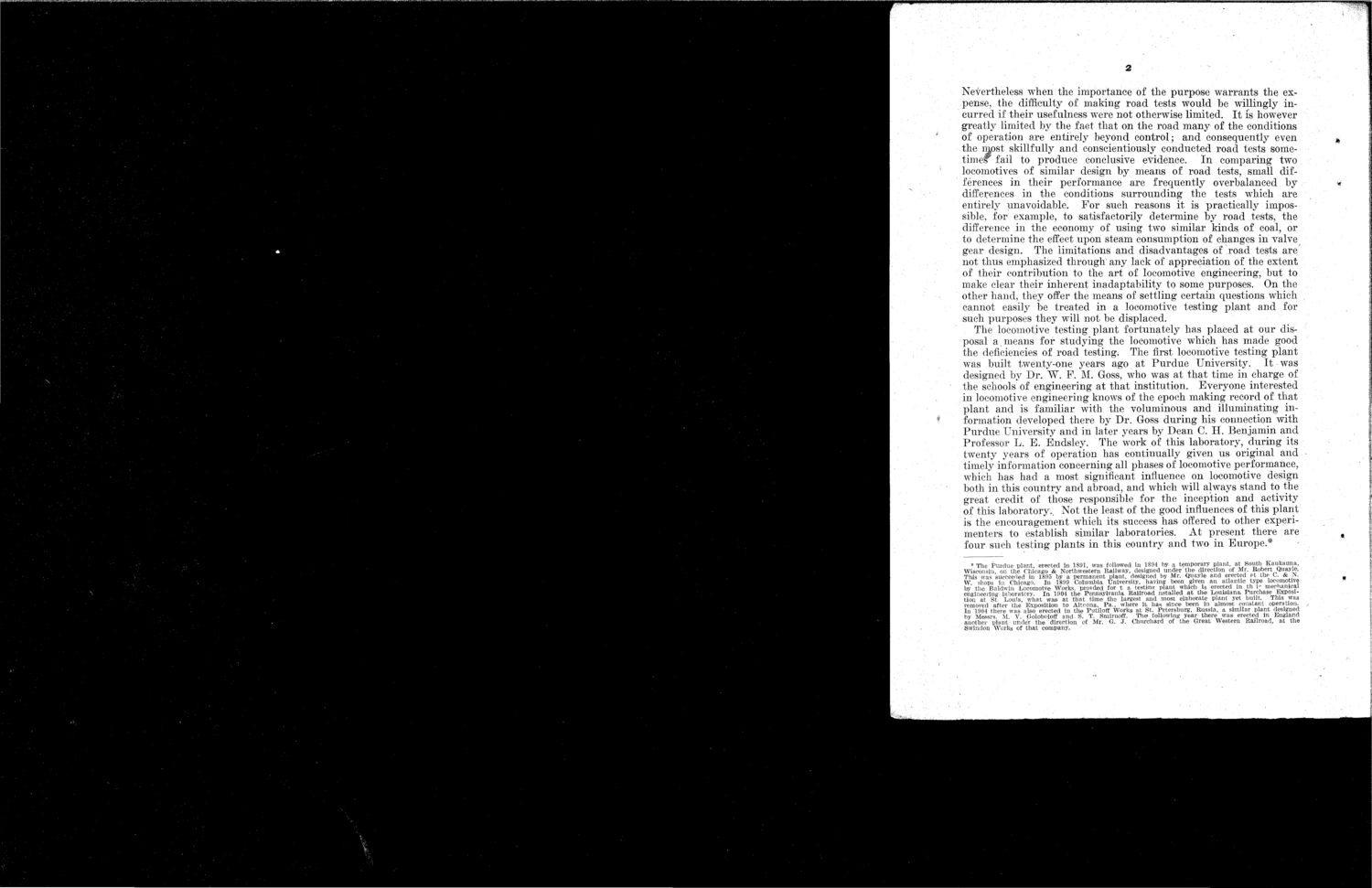| |
| |
Caption: Dedication - Locomotive Testing Laboratory (1913)
This is a reduced-resolution page image for fast online browsing.

EXTRACTED TEXT FROM PAGE:
a Nevertheless when the importance of the purpose warrants the expense, the difficulty of making road tests would be willingly incurred if their usefulness were not otherwise limited. I t is however greatly limited by the fact that on the road many of the conditions of operation are entirely beyond control; and consequently even the most skillfully and conscientiously conducted road tests some--.' times fail to produce conclusive evidence. In comparing two locomotives of similar design by means of road tests, small differences in their performance are frequently overbalanced by differences in the conditions surrounding the tests which are entirely unavoidable. For such reasons it is practically impossible, for example, to satisfactorily determine by road tests, the difference in the economy of using two similar kinds of coal, or to determine the effect upon steam consumption of changes in valve gear design. The limitations and disadvantages of road tests are not thus emphasized through any lack of appreciation of the extent of their contribution to the art of locomotive engineering, but to make clear their inherent inadaptability to some purposes. On the other hand, they offer the means of settling certain questions which cannot easily be treated in a locomotive testing plant and for such purposes they will not be displaced. The locomotive testing plant fortunately has placed at our disposal a means for studying the locomotive which has made good the deficiencies of road testing. The first locomotive testing plant was built twenty-one years ago at Purdue University. It was designed by Dr. "W. F. M. Goss, who was at that time in charge of the schools of engineering at that institution. Everyone interested in locomotive engineering knows of the epoch making record of that plant and is familiar with the voluminous and illuminating information developed there by Dr. Gross during his connection with Purdue University and in later years by Dean C. H. Benjamin and Professor L. E. Endsley. The work of this laboratory, during its twenty years of operation has continually given us original and timely information concerning all phases of locomotive performance, which has had a most significant influence on locomotive design both in this country and abroad, and which will always stand to the great credit of those responsible for the inception and activity of this laboratory., Not the least of the good influences of this plant is the encouragement which its success has offered to other experimenters to establish similar laboratories. At present there are four such testing plants in this country and two in Europe.* * The Purdue plant, erected in 1891, was followed in 1894 by a temporary plant, at South Kaukaiina, Wisconsin, on the Chicago & Northwestern Railway, designed under the direction of Mr. Robert Uuayle. This was succeeded in 1895 by a permanent plant, designed by Mr. Quayle and erected ot the C. & JN. W shops in Chicago. In 1899 Columbia University, having been given an atlantic type locomotive by the Baldwin Locomotve Works, provded for t a, testing plant which is erected in th ir mechanical engineering laboratory. I n 1904 the Pennsylvania Railroad nstalled at tne Louisiana Purchase -Exposition at St. Louis, what was at that time the largest and most elaborate plant yet built. This was removed after the Exposition to Altcona, Pa., where it has since been • in almost constant operation. In 1904 there was also erected in the Putiloff Works at St. Petersburg, Russia, a, similar plant designed by Messrs M V Goiobcioff and S. T. Smirnoff. The following year there wasi erected in England another plant-under the direction of Mr. G. J. Churchard of the Great Western Railroad, at the Swindon Works of that company.
| |